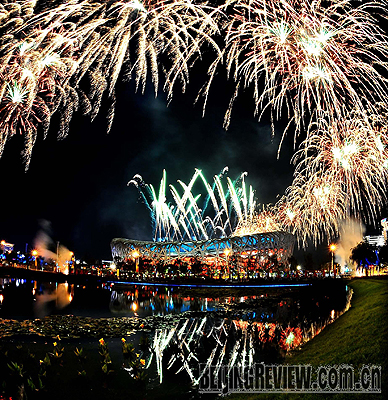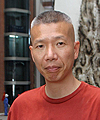|

FIERY SPECTACLE: Fireworks explode in the night sky above Beijing at the second rehearsal for the opening ceremony of the Beijing Olympics
The skies above Beijing were lit up with flashes and bangs on August 8, as a spectacular firework display marked the opening ceremony of the Olympic Games.

It was the work of Cai Guoqiang, General Designer for Visual Effects at the event, whose life has revolved around gunpowder.
Cai's work on the show began several years ago, when tenders were invited to produce the opening ceremony. Cai, who has lived outside of China much of his life, presented his design plan alongside big name directors including Zhang Yimou, Ang Lee and Chen Kaige and was later chosen for the event.
"The firework show at the opening ceremony of the Beijing Olympics lasted for no more than 20 minutes, but we spent three years preparing it," said Cai. "In 2005, 13 teams bid for this. After much discussion, many good ideas were rejected due to technology limitations, but the initial creative idea never changed. That was to display perfectly the harmony of heaven and human beings."
According to Cai, the firework show had to be consistent with the whole performance. At the beginning of the opening ceremony, 29 firework spots from Yongdingmen to the Bird's Nest were set alight, representing the 29th Olympic Games. Later on, a total of 70 firework spots across Beijing allowed people around the city to enjoy the spectacle.
Now that the opening ceremony is over, Cai feels more strongly about the size of the task he took on.
"I had to consider both art and technology," said Cai with a smile.
Exploding fireworks in a controlled manner is difficult, but Cai found ways to get the effects he wanted. For example, the fireworks in 22 spots across Beijing exploded together forming the shape of a dragon.
The height and angle of fireworks is hard to control. "This time, we tried many ways and adopted much technology and finally made the fireworks explode at the very height and angle we wanted," said Cai.
"It was very difficult for the fireworks to shape properly as we expected. The explosion time, height and how long the flash stayed in the sky were all hard to control. We had to make the explosion times very accurate. We input chips in some shells to control the time of their explosion."
The climax of the opening ceremony fireworks displayed 2,008 smiles. "This required every shell to shoot to a proper position," said Cai. "Only in this way could the audience see an intact smiling face. We spent more than two years in achieving this."
The semi-open structure of the Bird's Nest added more difficulties to the firework show. "There were no canopies in sports venues before, which made it easier for audiences to see firework displays. This time, we had to consider the audience view inside the venue as well as interaction with the audience outside."
In order to protect the membrane of the Bird's Nest, Cai and his team chose low-temperature fireworks and conducted many experiments both in the venue and outside.
"Thousands of people contributed to our creative ideas, including the research and development of new technology, material selection, and inspection of the quality of the products," said Cai.
Unexpected art
In October 2001, Cai won applaud for a firework show in Shanghai to celebrate an Asia-Pacific Economic Cooperation (APEC) conference. He made use of 27 buildings and Huangpu River for the show, which lasted for almost 20 minutes. It was regarded as a feast for the eyes.
"Actually, I like explosions more than fireworks. I like the speed and energy of the explosion. So my designs target the vitality of the fireworks, not just how fancy the shape is," said Cai. His interest in fireworks started in 1984, when he was a student in Shanghai Theatrical Institute.
Cai is also famous for his "powder paintings." He paints by arranging fireworks in fixed lines across paper laid on the ground. The explosions leave burned areas on the paper that creates a piece of artwork.
"I have tried many ways to paint, including making use of natural wind to blow oil pigment. I always wanted to make unexpected paintings rather than just paint step by step," said Cai. "Finally I chose gunpowder. It serves as pigment for me."
In 1986, Cai went to Japan for further study. In 1991, he held a solo exhibition of his powder paintings. In 1994, he exploded a large balloon hanging in the air in the central park of Hiroshima, Japan, igniting it using a 900-meter-long fuse.
For Cai, using gunpowder explosions to create art is a natural choice. When he was young, in his hometown of Quanzhou, Fujian Province, making fireworks was an important industry.
Cai has retained his boyhood fascination with gunpowder. "It is interesting, he said, with a glint of excitement in his eyes. "It is made of dust, but after the explosion, it becomes ashes and very quiet." |